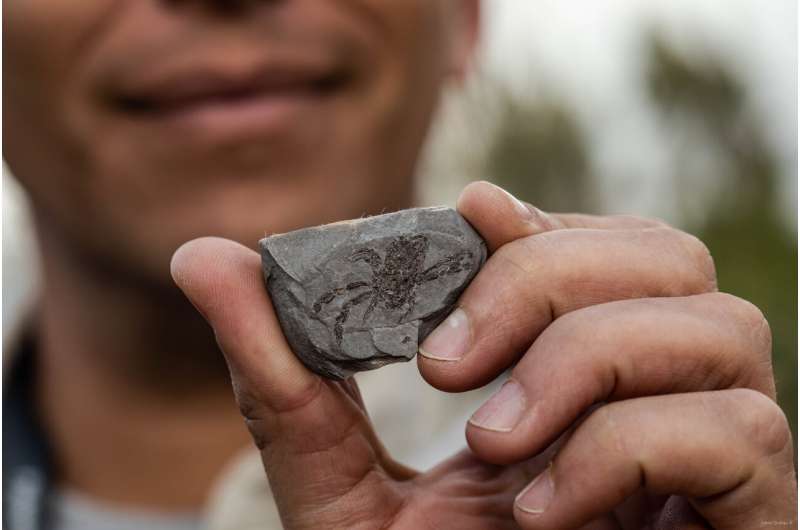The ‘Platypus’ of the crab world was an active predator that lurked the Cretaceous seas

Eyes are crucial players in the evolution of organisms. They allow an animal to find food, a mate, potential prey, to avoid predators and aid in regulating the internal clock by differentiating day from night. Eyes are also delicate features that tend to be not well preserved in fossil crustaceans.
One such rare finding is Callichimaera perplexa, a 95-million-year-old crab fossil discovered by senior author Javier Luque, postdoctoral fellow in the Department of Organismic and Evolutionary Biology at Harvard, and fully described in 2019 in the journal Sciences Avances. The fossil, found in a Cretaceous layer of rock in the Andes of Colombia, had rare preservation of both the external eye elements and the internal optic neural tissue. In a new study Luque and researchers from Yale describe the unusually large optical features of Callichimaera which suggest it was a highly visual, swimming predator.
Callichimaera’s eyes are one of its most unusual and striking feature due to their enormity. Living crabs usually have tiny compound eyes located at the end of a long stalk with an orbit to cover and protect. Callichimaera, however, has large compound eyes with no sockets to protect them. The researchers first thought Callichimaera was a crab in the last larval stage called megalopa, which means big eyes. In this stage crabs have very large eyes; however, this is a brief moment in the development of the crab. As the crab matures into a juvenile the body outgrows the eyes.
To test this, Luque and first author Kelsey Jenkins, Ph.D. candidate at Yale, analyzed over 1,000 specimens of living and extinct crabs representing 15 crab species from across the crab family tree. The specimens included crabs at different stages of development and encompassed a range of habitats, ecologies, lifestyles, and bathymetric ranges. They measured the dimensions of the eyes and bodies of the crab specimens from infant to adult and found that, unlike the other crab species, Callichimaera retained its large eyes throughout development. In fact, Callichimaera’s eyes were the fastest growing of all species and could reach up to 16% of their entire body, which is about the size of a quarter. For comparison imagine a human with eyes the size of soccer balls.
“Having such big and unprotected eyes implies that they were exposed at all times, plus eyes that big impose a huge investment of energy and resources to maintain them. Thus, this animal must have relied considerably on vision,” Luque said.
“If something has eyes this big, they’re definitely very highly visual. This is in stark contrast to crabs with tiny, vestigial eyes where they may only be 1 to 3% of the animal’s body size,” Jenkins said.

Further analysis showed that Callichimaera was an animal with high visual acuity similar to dragonflies—which are among the apex predators of the insect world—and a mantis shrimp. The remarkable preservation of internal soft tissues in the eyes of Callichimaera, such as the optic lobes (neural tissues), shows they were more similar to the eyes of bees and other large-eyed insects than the stalked eyes of crabs. The animal was also more adapted to well-lit conditions. All of the anatomical information available pointed towards Callichimaera being a predator.
“Even though it’s the cutest, smallest crab, the big eyes of Callichimaera and its overall body form with unusually large oar-like legs indicate that it might have been a fierce, swimming predator, rather than a bottom-crawler as most crabs are,” Luque said.
“Crabs whose eyes are growing very quickly are more visually inclined—likely they’re very good predators who use their eyes when hunting—whereas slow-growing eyes tend to be found in scavenger crabs that are less visually reliant,” said co-author Professor Derek E.G. Briggs, Yale.

Callichimaera’s continued surprise findings matches the name’s translation of “perplexing beautiful chimera.” “I call it my beautiful nightmare because it took me over a decade of visiting museums around the world and analyzing thousands of fossils and living crabs to understand how unique the animal was. It is so perplexing, so different from anything else, that it can be considered the platypus of the crab world,” Luque said. “The exceptional preservation of organisms with soft or lightly mineralized tissues, such as eyes, allows us to take new glimpses into the history and evolution of life through deep time in spectacular ways. To make sense of our present, we must look at our past, and for this, the data is in the strata.”

The study is available online at iScience. It will be available in print on January 21.
A crab’s-eye view of the ancient world
Kelsey M. Jenkins et al, The remarkable visual system of a Cretaceous crab, iScience (2021). DOI: 10.1016/j.isci.2021.103579
Provided by
Harvard University, Department of Organismic and Evolutionary Biology
Citation:
The ‘Platypus’ of the crab world was an active predator that lurked the Cretaceous seas (2022, January 12)
retrieved 12 January 2022
from https://phys.org/news/2022-01-platypus-crab-world-predator-lurked.html
This document is subject to copyright. Apart from any fair dealing for the purpose of private study or research, no
part may be reproduced without the written permission. The content is provided for information purposes only.
For all the latest Science News Click Here
For the latest news and updates, follow us on Google News.

